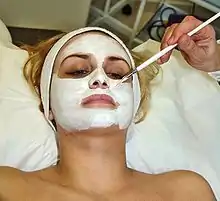Beauty salon
A beauty salon or beauty parlor (beauty parlour), or sometimes beauty shop, is an establishment dealing with cosmetic treatments for men and women.[1] There's a difference between a beauty salon and a beauty parlor which is that a beauty salon is a well developed space in a private location, usually having more features than a beauty parlor could have. Usually a beauty parlor concentrates on a specific treatment or beauty features such as styling either for men, women or for both. Also, a beauty parlor is a smaller and more community friendly place which is usually located at the owner's home. In some cases the owner is not only the boss, but probably the only worker, not having any other crew members. Other variations of this type of business include hair salons and spas.

There is a distinction between a beauty salon and a hair salon and although many small businesses do offer both sets of treatments; beauty salons provide extended services related to skin health, facial aesthetics, foot care, nail manicures, aromatherapy — even meditation, oxygen therapy, mud baths and many other services.
Beauty treatments

Massage for the body is a popular beauty treatment, with various techniques offering benefits to the skin (including the application of beauty products) and for increasing mental well-being. Hair removal is offered at some beauty salons through treatments such as waxing and threading. Some beauty salons style hair instead of going to a separate hair salon, and some also offer sun tanning. Other treatments of the face are known as facials. A facial is essentially a multi-step skin treatment that is one of the best ways to take care of your skin. A facial cleanses, exfoliates, and nourishes the skin, promoting a clear, well-hydrated complexion and can help your skin look younger. [2]Specialized beauty salons known as nail salons offer treatments such as manicures and pedicures for the nails. A manicure is a treatment for the hands, incorporating the fingernails and cuticles and often involving the application of nail polish, while a pedicure involves treatment of the feet, incorporating the toenails and the softening or removal of calluses.
Industry
Beauty salons have proven to be a recession-proof industry across United States. Although sales had declined from 2008 highs due to the Great Recession, they remain robust with long term positive forecast.[3] Even though during recessions, consumers tend to be more price conscious, spending continues to increase. With rising per capita incomes across the United States since 2015, beauty salons are booming with the industry generating $56.2 billion in the United States. Hair care is the largest segment with 86,000 locations. Skin care is expected to have revenue of almost $11 billion by 2018. This growth is being driven in part by a generally increasing awareness of the importance of skin care among American woman, but also specifically due to an increase in the market for men.[4] The market is distributed widely across America, with a concentration in the Northeast and Midwest. There is also a growing trend in boutique salons popping up and leveraging online marketing to gain customers and compete with the franchise chains.[5] The US Labor Department estimates employment in the United States will increase 20% between 2008–2014, with greatest employment growth from skin care specialists.[6]Beauty salons employ cosmetologists specializing in general beautification techniques. Cosmetology licensing requirements vary from state to state, and depending on which specific type of license is desired; general cosmetologist, hair stylist, esthetician, manicurist, barber, electrologist, or other.[7]
References
- "Beauty Salon | Definition of Beauty Salon by Lexico". Lexico Dictionaries | English.
- "Enhance Your Complexion With a Popular Spa Treatment". TripSavvy. Retrieved 2020-09-29.
- "2019 Beauty Salons Industry Statistics & Market Research Report - AnythingResearch". www.anythingresearch.com.
- "2020 U.S. Beauty Salons Industry-Industry & Market Report". www.marketresearch.com. Retrieved 2020-07-13.
- "U.S. Department of Labor | USAGov". www.usa.gov. Retrieved 2020-07-13.
- "US Bureau of Labor Statistics 2008-09". Archived from the original on December 4, 2008.
- "Beauty Salons and Beauty Salon Websites, Information and Listings - SalonBuilder.com". www.salonbuilder.com. Retrieved 2020-10-02.
| Wikimedia Commons has media related to Beauty salons. |